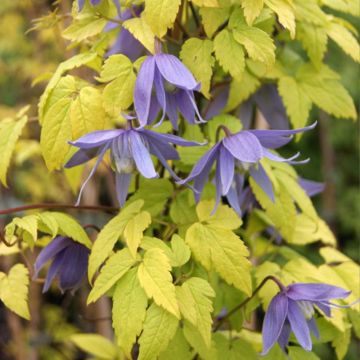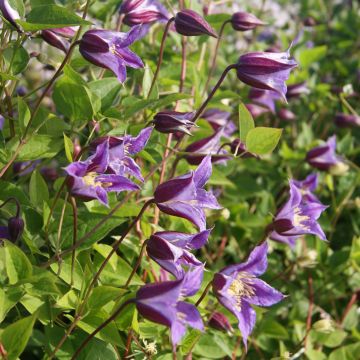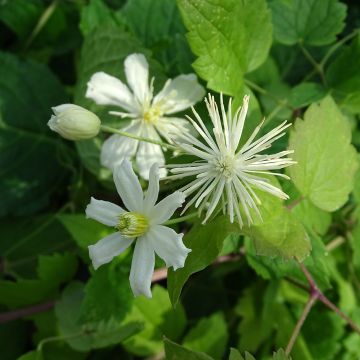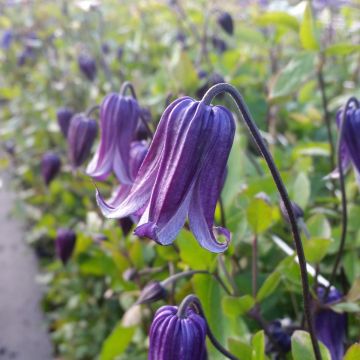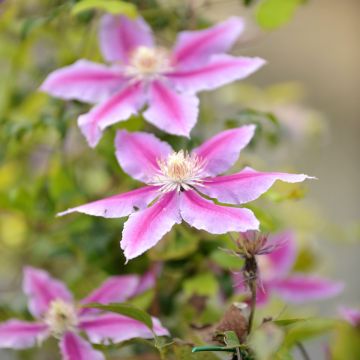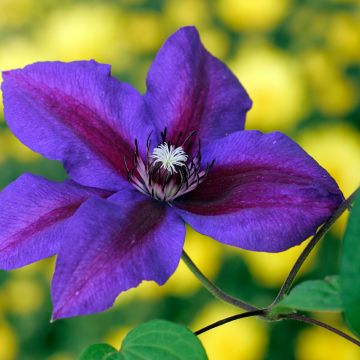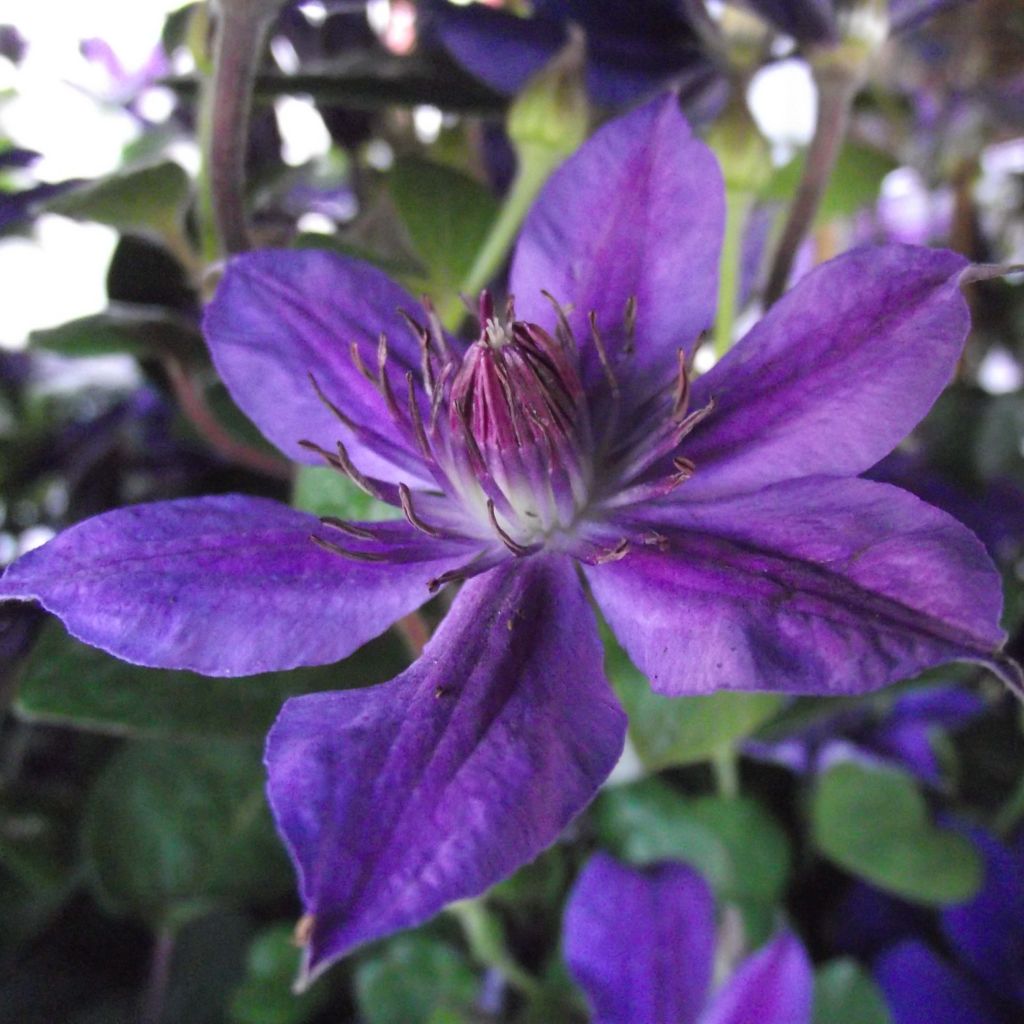

Clematis Mon Amour
Clematis Mon Amour
Clematis Mon Amour 'Zomoa'
Old Man's Beard, Traveller's Joy, Virgin's Bower, Leather Flower
The plant I received had only one branch. Planted near another clematis, it initially seemed to recover and even produced two beautiful flowers... but then the branch turned completely black and died :-((
Laurence, 30/08/2022
This item cannot be shipped to the selected country
Delivery charge from €5.90
More information
Schedule delivery date,
and select date in basket
This plant carries a 6 months recovery warranty
More information
We guarantee the quality of our plants for a full growing cycle, and will replace at our expense any plant that fails to recover under normal climatic and planting conditions.
From €5.90 for pickup delivery and €6.90 for home delivery
Express home delivery from €8.90.
Does this plant fit my garden?
Set up your Plantfit profile →
Description
The Clematis 'Mon Amour' provides a generous flowering, well distributed along its stems, as well as an original and rare intensity of colour. From June to September, this small vine blooms in successive waves of medium-sized star-shaped flowers, with an intense blue-violet colour and a nuanced purple-pink middle zone. The centre of the flower, occupied by beautiful violet stamens, further accentuates the unique colour of the flower. This variety, with modest growth, fits anywhere in a small garden, or even on a terrace or balcony.
Clematis belong to the Ranunculaceae family. They are found in both hemispheres, particularly in Europe, the Himalayas, China, Australia, and North and Central America. The 'Mon Amour' variety, introduced in the Netherlands in 2004, was first presented at the Chelsea Flower Show in 2012. It is a particularly floriferous plant, perfectly perennial and hardy, climbing, reaching a height of 2m (7ft) quickly, with a spread of at least 1m (3ft).
This clematis bears star-shaped flowers 8 to 10cm (3 to 4in) in diameter that appear along almost the entire length of the current year's shoots, from June to September. The flowers are solitary or grouped in clusters and particularly abundant. They are erect and have 4 to 6 wide, thick and velvety sepals, with a beautiful combination of dark blue-violet and pink-red. The flowering is followed by decorative feathery silver-grey fruits that persist until winter. The leaves are of moderate size, pinnate, with ovate, glabrous leaflets, and are fairly dark green. This clematis clings to the support or host plant through petioles transformed into tendrils. The deciduous foliage falls with the first frost.
Clematis like to have their feet in the shade and their heads in the sun, as well as well-drained soils that remain moist. Plant your clematis alongside your climbing roses or vines to extend the flowering of your walls and pergolas until the end of summer. Climbing honeysuckles will also be good companions, with their light and often fragrant flowers complementing the large scentless star-shaped corollas. The Clematis genus is rich in diversity, with varieties available in all colours, shapes and sizes. Take advantage of their easy cultivation to give your garden a romantic and bohemian touch. 'Mon Amour' loves to scramble through bushes and performs very well in a large pot.
Report an error about the product description
Clematis Mon Amour in pictures
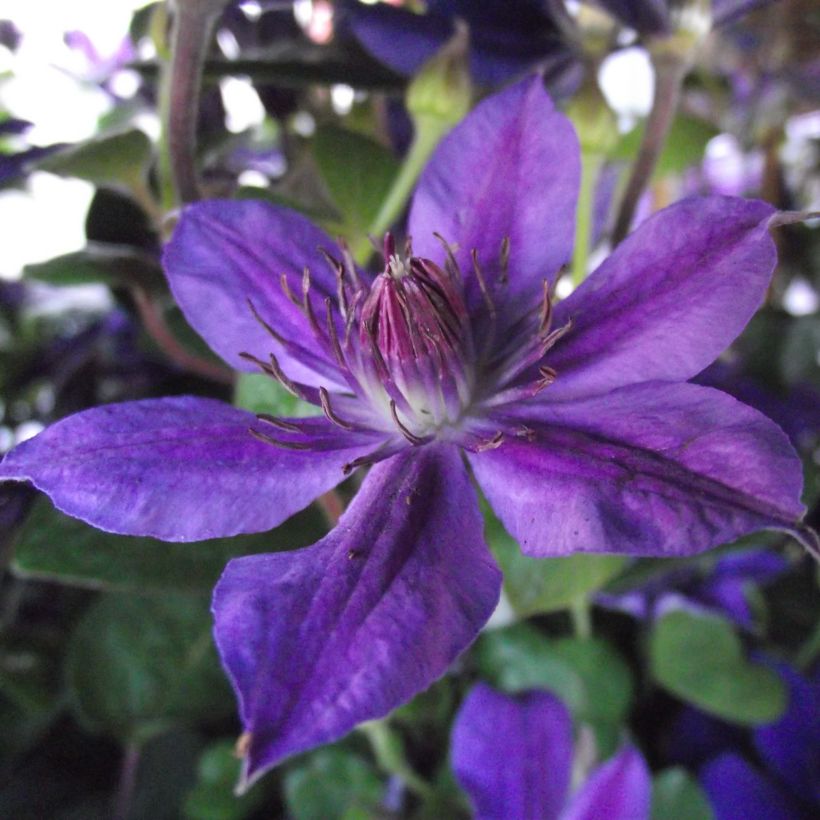

Plant habit
Flowering
Foliage
Botanical data
Clematis
Mon Amour 'Zomoa'
Ranunculaceae
Old Man's Beard, Traveller's Joy, Virgin's Bower, Leather Flower
Cultivar or hybrid
Other Clematis A to Z
Planting and care
The Clematis 'Mon Amour' will appreciate a sunny or lightly shaded position near a tree, with the base in the shade. Plant it in a fertile, humus-rich soil that remains moist, especially well-drained, shading the roots and the base of the stem (with a flat tile, for example). In general, clematis withers in overly wet soil. Install it by covering the root ball with 3 cm (1in) of soil, in a substrate worked to 20 cm (8in), lightened with good compost and coarse sand. After planting, cut back the clematis stems to about 30 cm (12in) from the base above a nice pair of buds. During the first few weeks, water regularly. However, be careful not to let the water stagnate, as this can cause fungus to develop at the collar. Mulch all clematis in February with garden compost or well-rotted manure, avoiding direct contact with the stems. Train the stems, without squeezing them, until the plant grips by itself. Clematis also like to grow freely on neighbouring plants. Prune in March to 30 cm (12in) above the ground.
After a few years, cover the base of your climbing clematis with a small mound of soil, this will reduce the risk of withering while promoting the growth of vigorous shoots from the stump. Voles and grey worms can attack clematis and devour the stems. Aphids and greenhouse whiteflies are also potential parasites of clematis.
Planting period
Intended location
Care
-
, onOrder confirmed
Reply from on Promesse de fleurs
Clematis
Haven't found what you were looking for?
Hardiness is the lowest winter temperature a plant can endure without suffering serious damage or even dying. However, hardiness is affected by location (a sheltered area, such as a patio), protection (winter cover) and soil type (hardiness is improved by well-drained soil).

Photo Sharing Terms & Conditions
In order to encourage gardeners to interact and share their experiences, Promesse de fleurs offers various media enabling content to be uploaded onto its Site - in particular via the ‘Photo sharing’ module.
The User agrees to refrain from:
- Posting any content that is illegal, prejudicial, insulting, racist, inciteful to hatred, revisionist, contrary to public decency, that infringes on privacy or on the privacy rights of third parties, in particular the publicity rights of persons and goods, intellectual property rights, or the right to privacy.
- Submitting content on behalf of a third party;
- Impersonate the identity of a third party and/or publish any personal information about a third party;
In general, the User undertakes to refrain from any unethical behaviour.
All Content (in particular text, comments, files, images, photos, videos, creative works, etc.), which may be subject to property or intellectual property rights, image or other private rights, shall remain the property of the User, subject to the limited rights granted by the terms of the licence granted by Promesse de fleurs as stated below. Users are at liberty to publish or not to publish such Content on the Site, notably via the ‘Photo Sharing’ facility, and accept that this Content shall be made public and freely accessible, notably on the Internet.
Users further acknowledge, undertake to have ,and guarantee that they hold all necessary rights and permissions to publish such material on the Site, in particular with regard to the legislation in force pertaining to any privacy, property, intellectual property, image, or contractual rights, or rights of any other nature. By publishing such Content on the Site, Users acknowledge accepting full liability as publishers of the Content within the meaning of the law, and grant Promesse de fleurs, free of charge, an inclusive, worldwide licence for the said Content for the entire duration of its publication, including all reproduction, representation, up/downloading, displaying, performing, transmission, and storage rights.
Users also grant permission for their name to be linked to the Content and accept that this link may not always be made available.
By engaging in posting material, Users consent to their Content becoming automatically accessible on the Internet, in particular on other sites and/or blogs and/or web pages of the Promesse de fleurs site, including in particular social pages and the Promesse de fleurs catalogue.
Users may secure the removal of entrusted content free of charge by issuing a simple request via our contact form.
The flowering period indicated on our website applies to countries and regions located in USDA zone 8 (France, the United Kingdom, Ireland, the Netherlands, etc.)
It will vary according to where you live:
- In zones 9 to 10 (Italy, Spain, Greece, etc.), flowering will occur about 2 to 4 weeks earlier.
- In zones 6 to 7 (Germany, Poland, Slovenia, and lower mountainous regions), flowering will be delayed by 2 to 3 weeks.
- In zone 5 (Central Europe, Scandinavia), blooming will be delayed by 3 to 5 weeks.
In temperate climates, pruning of spring-flowering shrubs (forsythia, spireas, etc.) should be done just after flowering.
Pruning of summer-flowering shrubs (Indian Lilac, Perovskia, etc.) can be done in winter or spring.
In cold regions as well as with frost-sensitive plants, avoid pruning too early when severe frosts may still occur.
The planting period indicated on our website applies to countries and regions located in USDA zone 8 (France, United Kingdom, Ireland, Netherlands).
It will vary according to where you live:
- In Mediterranean zones (Marseille, Madrid, Milan, etc.), autumn and winter are the best planting periods.
- In continental zones (Strasbourg, Munich, Vienna, etc.), delay planting by 2 to 3 weeks in spring and bring it forward by 2 to 4 weeks in autumn.
- In mountainous regions (the Alps, Pyrenees, Carpathians, etc.), it is best to plant in late spring (May-June) or late summer (August-September).
The harvesting period indicated on our website applies to countries and regions in USDA zone 8 (France, England, Ireland, the Netherlands).
In colder areas (Scandinavia, Poland, Austria...) fruit and vegetable harvests are likely to be delayed by 3-4 weeks.
In warmer areas (Italy, Spain, Greece, etc.), harvesting will probably take place earlier, depending on weather conditions.
The sowing periods indicated on our website apply to countries and regions within USDA Zone 8 (France, UK, Ireland, Netherlands).
In colder areas (Scandinavia, Poland, Austria...), delay any outdoor sowing by 3-4 weeks, or sow under glass.
In warmer climes (Italy, Spain, Greece, etc.), bring outdoor sowing forward by a few weeks.

































